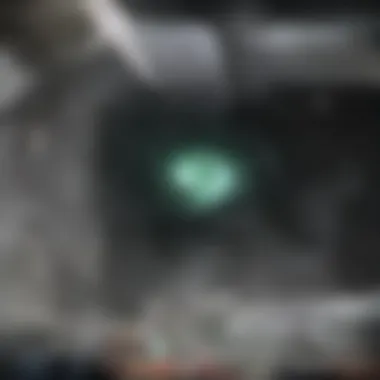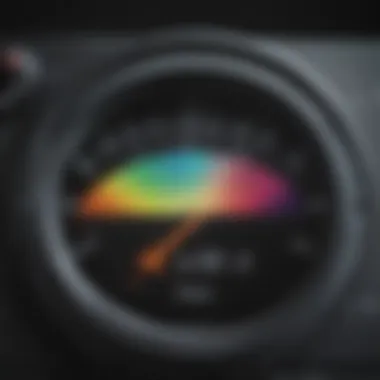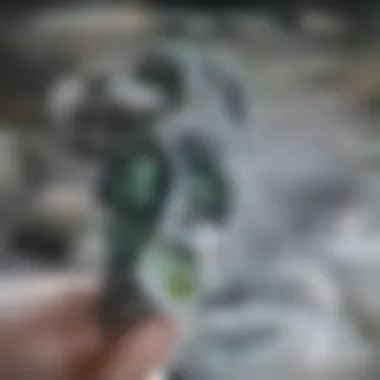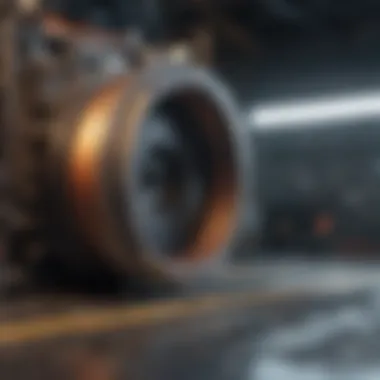Understanding SCR Emissions: Key Impacts and Solutions


Intro
Selective Catalytic Reduction (SCR) technology plays a significant role in controlling nitrogen oxide (NOx) emissions, especially from diesel engines and industrial processes. The urgency to address the environmental impacts of NOx has led to the adoption of SCR systems in various sectors. This initiative is not just a response to regulations but also a commitment to sustainable practices in industries.
The operation of SCR involves a chemical reaction process that transforms harmful NOx gases into harmless nitrogen and water. This mechanism requires the injection of a reductant, typically urea or ammonia, which facilitates the conversion. Understanding SCR emissions means appreciating not only how these systems work but also their implications for environmental policy and industrial practices.
In this article, we will detail the impacts stemming from SCR technology, delve into the regulations governing emissions, and examine the latest advancements designed to optimize SCR effectiveness. A thorough exploration of these dimensions will provide a well-rounded perspective on the current landscape of emissions control.
Key Findings
Major Results
- Significant Reduction of NOx Emissions: SCR systems have demonstrated their efficacy in considerably lower NOx emissions, achieving reductions by up to 90% in some applications.
- Compliance with Regulatory Standards: The adoption of SCR technology has allowed many industries to comply with stringent environmental regulations established to protect air quality.
- Evolution of Technology: Recent advancements in SCR technology include enhanced catalysts and improved urea injection systems, which have increased reliability and efficiency.
Discussion of Findings
The effectiveness of SCR technology is evident in various sectors, including automotive and industrial. By reducing NOx emissions significantly, SCR systems not only help in meeting regulatory requirements but also contribute to public health and environmental sustainability. However, implementing these systems requires a careful balance between operational costs and benefits.
Organizations employing SCR must also navigate the future landscape of emissions regulations, which are increasingly favoring cleaner technologies. Emerging technologies, such as real-time monitoring systems for SCR performance, further enhance the potential for efficient emissions control.
"SCR technology represents a pivotal shift in how industries manage emissions, merging economic viability with environmental responsibility."
Methodology
Research Design
The research conducted for this article primarily employed a qualitative approach. This design allowed for an in-depth understanding of SCR technology's role in emissions control.
Data Collection Methods
Data for this piece was gathered through a variety of sources, including:
- Academic journals focusing on environmental science and engineering.
- Regulatory reports issued by entities such as the Environmental Protection Agency.
- Case studies showcasing the implementation of SCR systems in different industries.
- Online forums for discussions among professionals in the field.
By compiling this information, the article aims to provide a comprehensive overview of SCR emissions, focusing on both their technological aspects and regulatory implications.
Prelims to SCR Emissions
The significance of Selective Catalytic Reduction (SCR) emissions control cannot be overstated in today's environmental landscape. The increasing push for sustainable practices across industries elevates the importance of understanding SCR technology. This section aims to elucidate key elements involved in SCR emissions, emphasizing the benefits and considerations that underpin this technology.
Definition of SCR
Selective Catalytic Reduction (SCR) is a sophisticated technology designed to reduce nitrogen oxides (NOx) emissions produced by diesel engines and various industrial processes. The technique involves a chemical reaction where a reductant, typically urea, is injected into the exhaust stream. This reaction occurs in the presence of a catalyst, which facilitates the conversion of NOx gases into harmless nitrogen and water vapor. SCR technology is crucial in meeting stringent emission standards established by environmental authorities globally.
Importance of Managing Emissions
Effective management of emissions is essential not just for compliance with regulations, but also for preserving environmental integrity. Since NOx emissions are primarily responsible for air pollution, their reduction translates to improved air quality. The implications extend beyond environmental benefits; there are economic incentives as well.
Managing emissions through SCR can enhance operational efficiency and may qualify industries for governmental incentives. Furthermore, raising awareness and understanding of SCR’s role can facilitate better public perception of industries, potentially leading to increased consumer trust.
"The adoption of SCR technology is not merely a regulatory mandate but also an opportunity for industries to demonstrate their commitment to sustainability."
In summary, the introduction to SCR emissions lays the groundwork for understanding regulatory landscapes and technological developments. It highlights the critical importance of emissions management in fostering industry advancements and ensuring compliance with regulatory measures.


Mechanisms Behind SCR Technology
The mechanisms of Selective Catalytic Reduction (SCR) technology are vital to understanding its effectiveness in reducing nitrogen oxide (NOx) emissions. One must appreciate how SCR systems achieve these reductions in order to grasp their impact on both environmental practices and regulatory standards. SCR technology relies on a catalytic process that facilitates the conversion of harmful NOx into harmless nitrogen and water. This process is not only sophisticated but also connects to various aspects of environmental science and industrial engineering, reflecting the need for advanced emission control measures in both automotive and industrial sectors.
Catalytic Reduction Process
The catalytic reduction process is the cornerstone of SCR technology. In this reaction, NOx emissions are converted through a chemical interaction facilitated by a catalyst. It typically occurs in three steps: adsorption, reaction, and desorption. First, the NOx molecules are adsorbed onto the catalyst surface. Next, the NOx is reduced to nitrogen (N2) when it reacts with ammonia (N), which is injected into the exhaust stream as a urea solution. Finally, the clean gases are released from the catalyst after the reduction reaction.
This process is not merely chemical; it embodies efficiency and effectiveness and addresses significant environmental concerns. By implementing prolonged catalytic activity, SCR technology can significantly lower NOx emissions, meeting stringent regulatory standards while also improving air quality. Moreover, the precise operation of the catalytic process requires careful engineering, whereby temperature and flow rates must be managed to optimize performance.
Role of Urea in SCR Systems
Urea plays a critical role in the operation of SCR systems. It is the most common reductant used to trigger the catalytic reaction that reduces NOx. The urea solution, often referred to as AdBlue in the automotive context, decomposes into ammonia when heated in the exhaust system. Once ammonia is present, it interacts directly with NOx within the catalytic unit, leading to the production of harmless nitrogen and water.
The effectiveness of urea in SCR systems is closely linked to its concentration and injection method. Proper dosing is essential; both insufficient and excess urea can lead to incomplete reduction or ammonia slip, which negates the benefits of the system. SCR systems must incorporate advanced sensors and control units to monitor and adjust the quantity of urea being injected into the exhaust stream. This dynamic management helps in maintaining compliance with environmental regulations while ensuring that fuel consumption does not increase unduly.
Types of Catalysts Used
The catalyst itself is a crucial component in the SCR process, and different types of catalysts can be employed depending on the system design and application. Most commonly, vanadium-based catalysts are used in industrial processes due to their high efficiency at varying temperatures. On the other hand, automotive SCR systems often employ zeolite-based catalysts, which offer better performance under the conditions typical of vehicle exhaust.
The choice of catalyst influences the overall effectiveness and lifespan of the SCR system. Catalyst poisoning is a significant challenge; impurities in fuel can adversely affect catalyst performance. Therefore, regular monitoring and maintenance of the catalyst, as well as careful fuel selection, are critical factors in the success of SCR technologies.
In summary, understanding the mechanisms behind SCR technology is essential for evaluating its role in emission reduction. Through the catalytic reduction process, the strategic use of urea, and appropriate catalyst selection, SCR systems have become pivotal for meeting environmental standards and addressing the challenges of increasing industrial activity and vehicular emissions.
Regulatory Framework Surrounding SCR Emissions
The regulatory framework for SCR emissions is crucial as it sets the standards and guidelines for exhaust emissions. These regulations, both international and national, aim to ensure that industries minimize their environmental impact while maintaining operational efficiency. Understanding this framework helps stakeholders make informed decisions regarding compliance and technology adoption.
International Emission Standards
International emission standards establish baseline requirements for nitrogen oxide (NOx) emissions from various sources. Organizations such as the International Organization for Standardization (ISO) and the World Health Organization (WHO) influence these regulations. The most notable example is the European Union's Euro emission standards, which dictate specific limits for NOx in diesel vehicles. These targets reflect a commitment to environmental sustainability and public health.
The establishment of international standards encourages countries to adopt similar regulations, fostering a global approach to air quality management. Compliance with these standards often involves periodic assessments and potential upgrades to existing technologies, including SCR systems. As research continues to progress, these standards may evolve, requiring ongoing adaptation and innovation in emission control technologies.
National Regulations and Compliance
National regulations vary widely based on each country's environmental policies and industrial capabilities. In the United States, the Environmental Protection Agency (EPA) sets stringent requirements for motor vehicles and industrial emissions. The Clean Air Act is a cornerstone legislation that empowers the EPA to enforce these standards. Companies are required to install SCR systems if their emissions exceed allowable thresholds.
Compliance necessitates rigorous testing and reporting. Facilities must demonstrate that their SCR systems are functioning effectively to avoid penalties. Non-compliance can result in significant fines, operational restrictions, or mandatory enforcement actions, underscoring the importance of adherence to these regulations.
Impact of Regulations on Industries
The impact of SCR-related regulations on industries can be profound. Initially, compliance may require substantial investments in technology and infrastructure. For instance, automotive manufacturers adapt by integrating SCR systems into their vehicles to meet regulatory requirements. This investment can increase production costs, which may ultimately be passed on to consumers. However, these expenditures can lead to long-term benefits, including improved fuel efficiency and reduced operating costs due to lower emissions penalties.
Moreover, adherence to strict regulations can enhance a company's reputation in sustainability, which can be a differentiator in the marketplace. Industries that proactively engage with emission regulations often find themselves better positioned within increasingly eco-conscious consumer bases.
"Regulations not only shape industry practices but also drive innovation in emission control technologies, ensuring a cleaner environment for all."
In summary, the regulatory framework surrounding SCR emissions is multi-faceted and influential. It guides international standards, national compliance requirements, and impacts industry practices. Understanding these elements is vital for effective management of SCR technologies.
Technological Innovations in SCR Systems
The examination of Selective Catalytic Reduction (SCR) systems reveals significant advancements that improve their operational effectiveness. In the context of stricter emissions regulations and the need for enhanced environmental responsibility, technological innovations are essential. These developments focus on optimizing SCR technology for better performance, reduced maintenance, and increased sustainability. Therefore, a deeper understanding of these innovations provides insight into the ongoing improvements in emission control systems.


Advancements in Catalyst Efficiency
Catalyst efficiency plays a crucial role in the functioning of SCR systems. Recent advancements in catalyst materials have led to significant improvements in conversion rates of nitrogen oxides (NOx) into harmless nitrogen and water vapor. These new catalyst formulations often utilize advanced metals like platinum and palladium, improving performance under varying conditions.
- Increased Activity: New catalysts can operate effectively at lower temperatures, which is essential for vehicles and machinery that may not run at optimal operating temperatures.
- Longevity: Innovations have also focused on extending the lifespan of catalysts, reducing the frequency of replacements, which lowers overall operational costs.
- Resistance to Poisoning: Enhanced designs are less prone to deactivation from sulfur and other contaminants, maintaining their efficiency for longer periods.
Improvement in Urea Distribution Systems
Effective urea distribution systems are vital to the overall performance of SCR technology. Recent innovations have focused on fine-tuning how urea is injected into exhaust systems, improving the reaction process.
- Precision Injection: Improved technologies allow for more accurate dosing of urea, which reduces waste and enhances the reaction of urea with NOx.
- Mixing Techniques: Better mixing systems ensure more consistent and efficient reactions, leading to a more complete reduction of NOx emissions.
- Real-time Monitoring: Some systems now incorporate sensors that monitor urea levels and adjust injection accordingly, ensuring optimal performance under variable engine loads.
Integration with Other Emission Control Technologies
Integration of SCR technology with other emission control systems can lead to comprehensive solutions for reducing overall emissions. Innovative approaches have emerged where SCR is combined seamlessly with diesel particulate filters (DPF) and other exhaust treatment technologies.
- Holistic Strategies: Combining SCR with DPF systems enables a greater reduction of both NOx and particulate matter from diesel engines, addressing multiple pollutants simultaneously.
- Efficiency Gains: Integrated systems can operate more efficiently since they are designed to work together, minimizing energy losses between different technologies.
- Regulatory Compliance: As regulations become more stringent, integrated systems often better meet the imposed standards, providing entities with compliance assurance while optimizing their processes.
The technological progress in SCR systems represents an important shift towards improving air quality and reducing environmental footprints. Embracing these innovations is critical for industries aiming to meet evolving regulations and public expectations.
Challenges in Implementing SCR Technology
Implementing Selective Catalytic Reduction (SCR) technology poses multiple challenges. Understanding these hurdles is vital for industries aiming to comply with emission regulations. These challenges can significantly affect the effectiveness and adoption of SCR systems. Below, we discuss three key challenges: operational limitations, economic considerations, and public perception.
Operational Limitations
SCR systems, while effective, are not without operational constraints. Factors such as engine temperature, speed, and load can influence the efficiency of the SCR process. For example, SCR technology works optimally within a specific temperature range. It often struggles in cold start conditions when the exhaust gas temperatures are low. This can hinder NOx reduction in certain driving conditions, particularly in urban settings.
Moreover, the maintenance of these systems can be complex. The urea solution, known as diesel exhaust fluid (DEF), must be regularly refilled and can crystallize if exposed to air for too long. This requires careful monitoring and operational practices that some industries may not be prepared for. Understanding these operational limitations is essential for optimizing SCR system performance and ensuring compliance with emission standards.
Economic Considerations and Costs
The economic aspects of SCR technology implementation cannot be overlooked. The installation of SCR systems incurs significant upfront costs, including hardware, installation, and training personnel. These financial demands can deter smaller businesses from adopting SCR solutions. Additionally, ongoing expenses such as DEF refills, maintenance, and periodic catalyst replacements can accumulate over time.
There are also indirect costs to consider. For instance, delays in meeting emission standards can lead to fines or penalties. These potential economic burdens must be carefully evaluated by industries contemplating SCR implementation. Conversely, successful adoption of SCR systems can lead to long-term savings and increased efficiency, making a compelling case for investment despite the initial costs.
Public Perception and Awareness
Public perception plays a crucial role in the implementation of emission control technologies like SCR. Many consumers and industry stakeholders lack awareness of how SCR technology contributes to environmental protection. This lack of knowledge can lead to skepticism about the necessity and effectiveness of such systems.
Education efforts are required to bridge this information gap. Communities need to understand the benefits of SCR systems, such as reduced air pollution and improved public health outcomes. Additionally, industries must communicate their commitment to sustainability. Increasing transparency about SCR technology can help build trust and support from the general public.
"Understanding operational limitations and economic considerations is essential for the successful integration of SCR technology in various sectors."
Epilogue
In summary, while SCR technology offers significant advantages for reducing NOx emissions, the challenges in its implementation are notable. Operational limitations, economic costs, and public perception must all be carefully considered. Each of these factors influences how effectively SCR systems can be utilized in diverse settings. Therefore, industries must adopt a strategic approach to overcome these challenges, ensuring that emission control efforts are both effective and sustainable.
Future Directions in SCR Technology
The landscape of Selective Catalytic Reduction (SCR) technology is continually evolving as a response to both environmental challenges and regulatory demands. Future directions within SCR technology are significant as they will likely influence not only how effectively we can control NOx emissions but also how industries adapt to changing regulations and expectations from society. The ongoing pursuit of more efficient and economically viable solutions is critical for both environmental policy and industrial sustainability. In this section, we will explore emerging research areas within SCR technology and potential policy changes that may drive industry adaptations.
Emerging Research Areas


Research in SCR technology is branching into several areas aimed at enhancing performance and reducing costs. Key focus areas include:
- Nanomaterials and Catalysts: The development of advanced catalysts, such as those based on nanomaterials, shows promise in improving the operational efficiency of SCR systems. These materials can enhance the reaction rates while potentially reducing the amount of urea needed for the reduction process.
- Sensor Technology: Improved sensors for monitoring and controlling SCR systems are under development. These devices can provide real-time data, allowing for optimization of the urea injection process, thus improving effectiveness.
- Alternative Reductants: Besides urea, researchers are exploring other reductants that may be more efficient or sustainable. Substitutes could reduce dependency on urea and tackle supply chain and cost issues.
- Hybrid Systems Integration: There is an emerging trend toward integrating SCR systems with other emissions reduction technologies, such as particulate filters or diesel oxidation catalysts. This multi-faceted approach could yield better overall performance in reducing both NOx and particulate matter.
Potential Policy Changes and Industry Adaptations
Policy frameworks influence how technology evolves. As pressure mounts for stricter emissions standards, stakeholders must adapt. Some potential changes include:
- Increased Regulatory Standards: Governments worldwide are likely to implement stricter regulations in response to climate change and public health concerns. This would compel industries to invest more in SCR technologies.
- Incentives for Clean Technologies: With environmental sustainability becoming a priority, incentives might be introduced to encourage adoption of advanced SCR systems, pushing industries toward innovations and efficiency improvements.
- Collaborative Frameworks: As research progresses, partnerships between academia, industries, and regulatory bodies may foster innovation in SCR technologies, ensuring that both environmental and economic objectives are met.
"The next wave of SCR technology development will significantly depend on how well industries can adapt to evolving regulations and pursue innovative solutions."
Case Studies on SCR Implementation
The significance of case studies in the context of Selective Catalytic Reduction (SCR) technology cannot be overstated. They provide concrete evidence of how SCR systems function in real-world scenarios, showcasing both their effectiveness and efficiency in reducing nitrogen oxide (NOx) emissions. By examining specific implementations of SCR technology, stakeholders can gather important insights into best practices, operational challenges, and the impact of regulatory compliance. This section will delve into notable case studies that illustrate successful applications of SCR in various sectors.
Successful Applications in the Automotive Sector
The adoption of SCR technology in the automotive sector marks a pivotal turning point in reducing vehicular emissions. A prime example is the implementation of SCR in heavy-duty trucks, such as those produced by Volvo and Daimler. In these applications, urea solution is injected into the exhaust stream, resulting in a chemical reaction that converts NOx into harmless nitrogen and water.
Key benefits observed from these applications include:
- Significant Reduction in NOx Emissions: Many manufacturers have reported reductions exceeding 90% in NOx emissions when employing SCR systems.
- Enhanced Fuel Efficiency: By optimizing combustion processes alongside SCR, vehicles demonstrate improved fuel economy.
- Compliance with Stricter Regulations: The transition to SCR technology helps manufacturers meet rigorous emissions standards outlined in guidelines like Euro 6.
However, challenges remain. Issues such as the need for regular maintenance of the urea injection system can raise concerns among fleet operators. Additionally, public perception plays a crucial role in the adoption of such technologies, necessitating ongoing education about SCR benefits.
Industrial Applications and Impact
In addition to automotive uses, SCR technology finds substantial applications in industrial settings. Companies like General Electric have implemented SCR systems in coal-fired power plants to control NOx emissions. These implementations reveal several impactful elements:
- Utility Scale Reductions: SCR has proven to effectively minimize NOx emissions from industrial sources, aligning with environmental commitments.
- Cost-Effectiveness: Though initial investment costs can be high, many industries report long-term savings in operational costs due to improved compliance and reduced penalties.
- Adaptability: SCR systems can be retrofitted to existing facilities, allowing industries to upgrade their emissions controls without complete overhauls.
The industrial sector has shown a growing commitment to reducing environmental footprints. This progress is reflected in the successful incorporation of SCR technology, which also contributes to the overall public perception of industries prioritizing sustainability.
Implementing SCR technology showcases a commitment to environmental stewardship while addressing regulatory requirements and public concerns.
Evaluating these case studies emphasizes the necessity for a proactive approach in emission control technologies. By adapting lessons learned from these real-world implementations, both automotive and industrial sectors can continue pushing the frontiers of sustainable practices.
Finale and Implications
The examination of Selective Catalytic Reduction (SCR) technology provides significant insights into its role in reducing nitrogen oxide (NOx) emissions. The importance of this topic lies not only in its environmental impact but also in its implications across multiple sectors. As global air quality deteriorates, emphasis on effective emissions control becomes paramount. SCR technology presents a viable solution to minimize harmful emissions from diesel engines and industrial processes.
Understanding the challenges and advancements in SCR systems aids stakeholders, including policymakers and industrial leaders. Awareness allows for better planning and decision-making regarding air quality management. Moreover, this knowledge underscores the importance of adopting responsible practices to enhance regulatory compliance.
> "Selective Catalytic Reduction represents a bridge between technological innovation and environmental responsibility."
Summary of Findings
The article reveals several key findings:
- SCR technology effectively reduces NOx emissions through a chemical reaction facilitated by catalysts and urea.
- Regulatory frameworks at both international and national levels significantly influence SCR deployment, shaping industry practices.
- Current technological advancements focus on improving catalyst efficiency and integrating SCR with other emission control systems.
- Organizations face various challenges implementing SCR, including costs, operational limitations, and public perception.
These findings highlight the critical balance between technology, regulation, and public engagement in achieving effective emission control.
The Future of SCR in Emission Control
Looking ahead, the future of SCR technology appears promising yet demanding. Emerging research areas focus on:
- Developing new catalyst materials that provide improved efficiency and durability.
- Exploring hybrid systems integrating SCR with alternatives like electric drives and alternative fuels.
- Anticipating potential policy changes that may introduce stricter regulations on emissions, urging industries to adapt proactively.
The collaboration between engineers, researchers, and policymakers will be crucial in navigating these transformations. Ultimately, the ongoing evolution of SCR technology presents an opportunity not only for compliance but also for innovation that can lead to cleaner air and sustainable practices.



